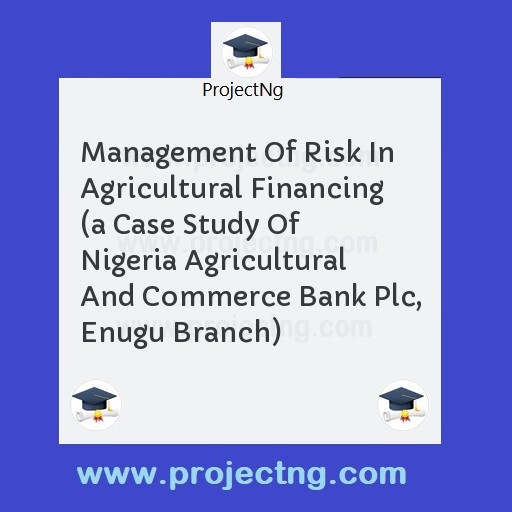Management Of Risk In Agricultural Financing (a Case Study Of Nigeria Agricultural And Commerce Bank Plc, Enugu Branch)
Accounting Project Topics
Get the Complete Project Materials Now! »
MANAGEMENT OF RISK IN AGRICULTURAL FINANCING (A CASE STUDY OF NIGERIA AGRICULTURAL AND COMMERCE BANK PLC, ENUGU BRANCH)
TABLE OF CONTENTS
Title page
Approval page
Dedication
Acknowledgement
Table of contents
Abstract
CHAPTER ONE:
1.0 Introduction
1.1 Background of the study
1.2 Statement of the problem
1.3 Objectives of the study
1.4 Significance of the study
1.5 Statement of hypothesis
1.6 Research Question
1.7 Scope and Limitation of the study
1.8 Definition of terms
CHAPTER TWO:
2.0 Literature review
2.1 Project Management
2.2 Management Techniques
2.3 Role of Finance in Agricultural development
2.4 Risk in agriculture
2.5 Poverty alleviation through agriculture
2.6 Farmer defence against risk and uncertainty
2.7 Uncertainty precautions
CHAPTER THREE:
3.0 Research design and methodology
3.1 Source of data
3.2 Source of primary data
3.3 Source of secondary data
3.4 Literature question
3.5 Sample used
CHAPTER FOUR:
4.0 Data presentation and analysis
4.1 Presentation of data
4.2 Analysis of data
4.3 Test of hypothesis
4.4 Interpretation of result
CHAPTER FIVE:
5.0 Summary of finding
5.1 Discussion of finding
5.2 Conclusion
5.3 Recommendation
Bibliography
Appendices
CHAPTER ONE
1.0 INTRODUCTION
1.1 BACKGROUND OF THE STUDY
Agriculture has been the main stay of Nigerian economy before the Nigeria independence until the era of oil boom. Statistics show that in 1963/64 agriculture provided about 50% of the Gross National Product (GNP) and 88% of the country’s basic foreign exchange earner of crops like palm oil, palm kernels, cocoa, cotton, groundnut, cereal, woods as raw material for their industries.
Although after independence a gradual drift in cities in search of white-collar jobs began and this handicapped the agricultural sector, which lead to a serious decline in agricultural produce, compounding this problem is the oil euphoria, which added more impetus to population drift and neglect thereby leading to Nigeria’s loss of agricultural manpower. Nigeria quickly turned from a food exporting country with bill accounting for 18% in 1979 and more than 26% in 1983. Total import bill at this rate compared with 8.5% in 1971 was a sign of total collapse of the agricultural sector.
It is in realization of the importance of agriculture in overall economic growth and development of any nation that various Nigerian governments (military and civilian administration) decided to take a bold and realistic step to bring agriculture back to its position of prominence in the national economy. Government has played significant roles in Agriculture financing with several strategies towards risk management. Some of these role are:
1. SUBSIDIES: Aimed at encouraging farmers to produce more. The effect of subsidy reduces the cost of production for the producers since they will be required to pay less per unit of farm inputs (fertilizers seeds palm). Also the producers are able to purchase more of these subsidy inputs, which if used intensively as recommended will lead to increased product. The resultant effect would be fall in prices if demand does not increase more than proportionately.
2. AGRICULTURAL RESEARCH INSTITUTE: The establishment of the research institute to develop high yielding and the disease resistant seedlings and livestocks. Such research institutes are National Roots Research Institute, Ibadan and Livestock Research Institute Von etc.
3. FARM SETTLEMENT: This was established in early 60’s. It involves the government in the acquisition of land for agricultural production and marketing. By this means farmers were able to get parcels of land from the government without actually paying for the lands in order to enhance their agricultural products.
4. LAND USE DECREE OF 1978: In this year the government promulgated the Land Use Act which sought to vest ownership of land on government. The use of land for agricultural purpose was recognized under this act with a view to eliminating the customers impediment to mechanization.
5. STRATEGIC GRAIN RESERVE: The original target of the federal government was to build up to 250,000 tonnes strategic grain reserves capacity during the 1975 – 80 development plan period. But very unfortunately very little was achieved because of the light domestic market situation.
6. OPERATION FEED THE NATION (OFN): The take-off of operation feed the nation was aimed at boosting food production for the growing nation and to encourage everybody to be involved in farming irrespective of social status but unfortunately this could not live long due to change of government.
7. FINANCIAL INSTITUTION: Research finding has shown that agricultural finance is very important. Based on this the federal government established Nigerian Agricultural Co-operative Bank (NACB) in 1973 to help in managing and financing agricultural production. Commercial banks were also given credit calling by the federal government through the Central Bank of Nigeria (CBN) to contribute towards agricultural financing and also authorized to open up rural branches.
8. AGRICULTURAL CREDIT GUARANTEE SCHEME:
This decree of 1977 No. 20 was established with N100m which 60% of the subscription was made up of the federal government and 40% by Central Bank of Nigeria. This was meant to help farmers in their need necessary to boost agricultural produce and on the other hand to provide guarantee in respect of loans granted by commercial and merchant banks for agricultural purpose with the aim of increasing the level of bank credit to the agricultural sector. The liability to the guaranteed fund is
Be the First to Share On Social

Enjoying our content?
Don't miss out on new videos! Subscribe to our YouTube channel for more awesome content.
Subscribe Now!













